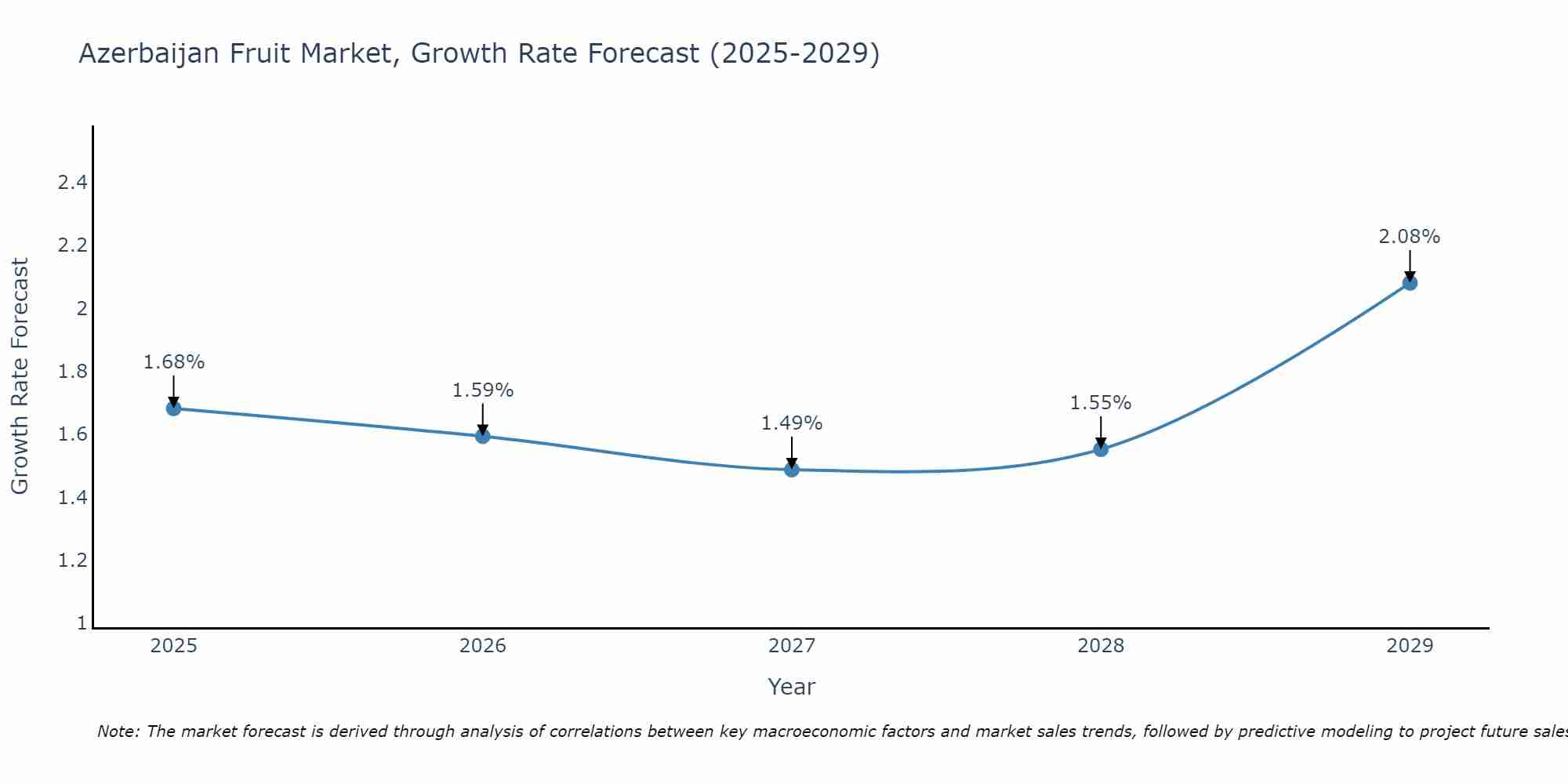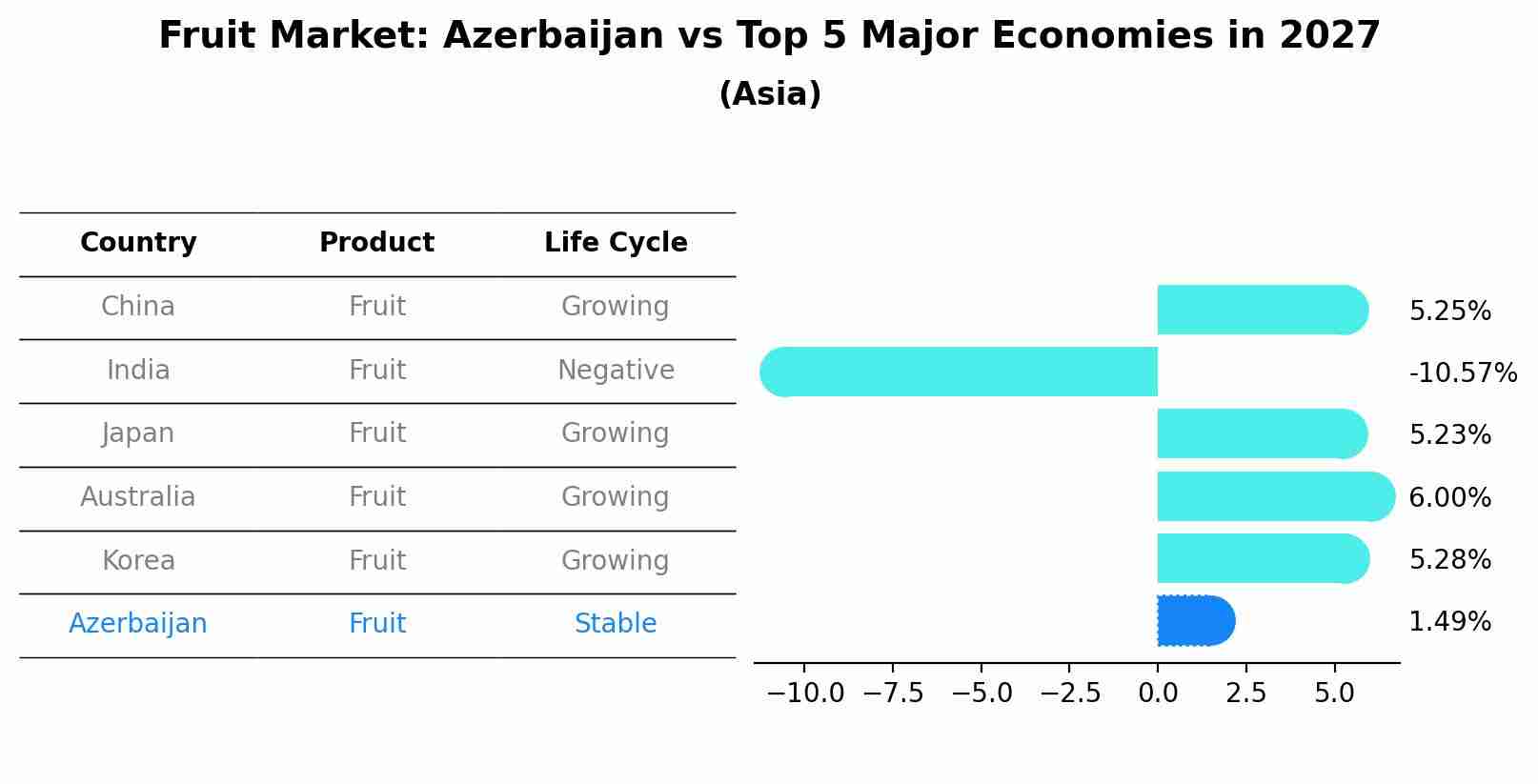Azerbaijan Fruit Market (2025-2031) | Trends, Value, Revenue, Growth, Companies, Outlook, Forecast, Analysis, Size, Industry & Share
| Product Code: ETC020057 | Publication Date: Oct 2020 | Updated Date: Jun 2025 | Product Type: Report | |
| Publisher: 6Wresearch | Author: Shubham Deep | No. of Pages: 70 | No. of Figures: 35 | No. of Tables: 5 |
Azerbaijan Fruit Market Size Growth Rate
The Azerbaijan Fruit Market is projected to witness mixed growth rate patterns during 2025 to 2029. The growth rate starts at 1.68% in 2025 and reaches 2.08% by 2029.

Fruit Market: Azerbaijan vs Top 5 Major Economies in 2027 (Asia)
The Fruit market in Azerbaijan is projected to grow at a stable growth rate of 1.49% by 2027, within the Asia region led by China, along with other countries like India, Japan, Australia and South Korea, collectively shaping a dynamic and evolving market environment driven by innovation and increasing adoption of emerging technologies.

Azerbaijan Fruit Market Overview
The Azerbaijan fruit market is characterized by a diverse range of fruits including apples, pomegranates, grapes, and persimmons. Local fruits such as figs, quinces, and medlars are also popular. The market is primarily driven by domestic production, with a focus on traditional farming methods. However, there is also a growing trend towards modernization and the adoption of greenhouse technologies to increase year-round production. The market is influenced by seasonal variations, with summer fruits being particularly in demand during the warmer months. Retail outlets, traditional bazaars, and supermarkets are the main distribution channels for fruits in Azerbaijan. Overall, the fruit market in Azerbaijan offers a mix of traditional and modern products, catering to a wide range of consumer preferences.
Azerbaijan Fruit Market Trends
Currently, the Azerbaijan Fruit Market is experiencing a shift towards more sustainable and organic practices as consumer demand for healthier and environmentally friendly options grows. There is a noticeable increase in the availability of organic fruits in supermarkets and specialty stores, reflecting a growing interest in pesticide-free produce. Additionally, there is a focus on promoting locally grown fruits to support domestic agriculture and reduce reliance on imports. Convenience and packaging are also key trends, with a rise in demand for pre-cut and packaged fruits for on-the-go consumption. Overall, the market is evolving to meet the changing preferences of consumers towards healthier, fresher, and more sustainable fruit options.
Azerbaijan Fruit Market Challenges
In the Azerbaijan fruit market, several challenges are faced by both producers and consumers. One major challenge is the lack of modern infrastructure and technology for cultivation, storage, and transportation, leading to high post-harvest losses and reduced product quality. Limited access to financing and technical support further hinders the growth and competitiveness of the industry. Additionally, fluctuations in weather patterns and the impact of climate change pose risks to crop yields and overall production. Inconsistent quality standards and market regulations also create uncertainties for both producers and consumers. Addressing these challenges would require investments in improving infrastructure, providing training and support to farmers, implementing sustainable farming practices, and developing effective market policies to ensure a more stable and flourishing fruit market in Azerbaijan.
Azerbaijan Fruit Market Investment Opportunities
The Azerbaijan fruit market presents various investment opportunities for both local and foreign investors. With a growing consumer demand for fresh and high-quality fruits, there is potential for investments in modernizing and expanding fruit orchards, implementing advanced farming techniques, and improving distribution channels to ensure efficient delivery to markets. Additionally, there is a rising trend towards organic and sustainably produced fruits, offering opportunities for investments in eco-friendly farming practices. Foreign investors can also explore partnerships with local producers to leverage their expertise and access to the domestic market. Overall, the Azerbaijan fruit market is ripe for investments that focus on enhancing product quality, increasing productivity, and meeting the evolving preferences of consumers.
Azerbaijan Fruit Market Government Policy
The government of Azerbaijan has implemented various policies to support and regulate the fruit market in the country. These policies include providing subsidies to fruit farmers to promote production, investing in infrastructure to improve transportation and storage facilities, and implementing quality control measures to ensure the safety and standards of fruits sold in the market. Additionally, the government has established marketing boards to facilitate the distribution of fruits both domestically and internationally, as well as to regulate prices and prevent market manipulation. Overall, these policies aim to promote growth in the fruit market, support local farmers, and ensure the availability of high-quality fruits for consumers in Azerbaijan.
Azerbaijan Fruit Market Future Outlook
The future outlook for the Azerbaijan fruit market appears promising, driven by increasing consumer demand for fresh and healthy produce. Factors such as rising disposable incomes, changing dietary preferences towards natural and organic products, and a growing awareness of the health benefits of fruits are expected to drive market growth. Additionally, advancements in agricultural practices, technology adoption for cultivation, and government initiatives to support the agriculture sector are likely to contribute to the market`s expansion. With a favorable climate for fruit cultivation and a strategic location for export opportunities, the Azerbaijan fruit market is poised for steady growth in the coming years, attracting investments and fostering innovation in the sector.
Key Highlights of the Report:
- Azerbaijan Fruit Market Outlook
- Market Size of Azerbaijan Fruit Market, 2024
- Forecast of Azerbaijan Fruit Market, 2026
- Historical Data and Forecast of Azerbaijan Fruit Revenues & Volume for the Period 2021 - 2031
- Azerbaijan Fruit Market Trend Evolution
- Azerbaijan Fruit Market Drivers and Challenges
- Azerbaijan Fruit Price Trends
- Azerbaijan Fruit Porter's Five Forces
- Azerbaijan Fruit Industry Life Cycle
- Historical Data and Forecast of Azerbaijan Fruit Market Revenues & Volume By Applications for the Period 2021 - 2031
- Historical Data and Forecast of Azerbaijan Fruit Market Revenues & Volume By Supermarkets and Hypermarkets for the Period 2021 - 2031
- Historical Data and Forecast of Azerbaijan Fruit Market Revenues & Volume By Specialty Stores for the Period 2021 - 2031
- Historical Data and Forecast of Azerbaijan Fruit Market Revenues & Volume By Online for the Period 2021 - 2031
- Historical Data and Forecast of Azerbaijan Fruit Market Revenues & Volume By Type for the Period 2021 - 2031
- Historical Data and Forecast of Azerbaijan Fruit Market Revenues & Volume By Fresh for the Period 2021 - 2031
- Historical Data and Forecast of Azerbaijan Fruit Market Revenues & Volume By Dried for the Period 2021 - 2031
- Historical Data and Forecast of Azerbaijan Fruit Market Revenues & Volume By Frozen for the Period 2021 - 2031
- Historical Data and Forecast of Azerbaijan Fruit Market Revenues & Volume By Others for the Period 2021 - 2031
- Azerbaijan Fruit Import Export Trade Statistics
- Market Opportunity Assessment By Applications
- Market Opportunity Assessment By Type
- Azerbaijan Fruit Top Companies Market Share
- Azerbaijan Fruit Competitive Benchmarking By Technical and Operational Parameters
- Azerbaijan Fruit Company Profiles
- Azerbaijan Fruit Key Strategic Recommendations
Frequently Asked Questions About the Market Study (FAQs):
1 Executive Summary |
2 Introduction |
2.1 Key Highlights of the Report |
2.2 Report Description |
2.3 Market Scope & Segmentation |
2.4 Research Methodology |
2.5 Assumptions |
3 Azerbaijan Fruit Market Overview |
3.1 Azerbaijan Country Macro Economic Indicators |
3.2 Azerbaijan Fruit Market Revenues & Volume, 2019 & 2026F |
3.3 Azerbaijan Fruit Market - Industry Life Cycle |
3.4 Azerbaijan Fruit Market - Porter's Five Forces |
3.5 Azerbaijan Fruit Market Revenues & Volume Share, By Applications, 2019 & 2026F |
3.6 Azerbaijan Fruit Market Revenues & Volume Share, By Type, 2021 & 2031F |
4 Azerbaijan Fruit Market Dynamics |
4.1 Impact Analysis |
4.2 Market Drivers |
4.3 Market Restraints |
5 Azerbaijan Fruit Market Trends |
6 Azerbaijan Fruit Market, By Types |
6.1 Azerbaijan Fruit Market, By Applications |
6.1.1 Overview and Analysis |
6.1.2 Azerbaijan Fruit Market Revenues & Volume, By Applications, 2016 - 2026F |
6.1.3 Azerbaijan Fruit Market Revenues & Volume, By Supermarkets and Hypermarkets, 2016 - 2026F |
6.1.4 Azerbaijan Fruit Market Revenues & Volume, By Specialty Stores, 2016 - 2026F |
6.1.5 Azerbaijan Fruit Market Revenues & Volume, By Online, 2016 - 2026F |
6.2 Azerbaijan Fruit Market, By Type |
6.2.1 Overview and Analysis |
6.2.2 Azerbaijan Fruit Market Revenues & Volume, By Fresh, 2016 - 2026F |
6.2.3 Azerbaijan Fruit Market Revenues & Volume, By Dried, 2016 - 2026F |
6.2.4 Azerbaijan Fruit Market Revenues & Volume, By Frozen, 2016 - 2026F |
6.2.5 Azerbaijan Fruit Market Revenues & Volume, By Others, 2016 - 2026F |
7 Azerbaijan Fruit Market Import-Export Trade Statistics |
7.1 Azerbaijan Fruit Market Export to Major Countries |
7.2 Azerbaijan Fruit Market Imports from Major Countries |
8 Azerbaijan Fruit Market Key Performance Indicators |
9 Azerbaijan Fruit Market - Opportunity Assessment |
9.1 Azerbaijan Fruit Market Opportunity Assessment, By Applications, 2019 & 2026F |
9.2 Azerbaijan Fruit Market Opportunity Assessment, By Type, 2019 & 2026F |
10 Azerbaijan Fruit Market - Competitive Landscape |
10.1 Azerbaijan Fruit Market Revenue Share, By Companies, 2024 |
10.2 Azerbaijan Fruit Market Competitive Benchmarking, By Operating and Technical Parameters |
11 Company Profiles |
12 Recommendations |
13 Disclaimer |
- Single User License$ 1,995
- Department License$ 2,400
- Site License$ 3,120
- Global License$ 3,795
Search
Thought Leadership and Analyst Meet
Our Clients
Related Reports
- Canada Oil and Gas Market (2026-2032) | Share, Segmentation, Value, Industry, Trends, Forecast, Analysis, Size & Revenue, Growth, Competitive Landscape, Outlook, Companies
- Germany Breakfast Food Market (2026-2032) | Industry, Share, Growth, Size, Companies, Value, Analysis, Revenue, Trends, Forecast & Outlook
- Australia Briquette Market (2025-2031) | Growth, Size, Revenue, Forecast, Analysis, Trends, Value, Share, Industry & Companies
- Vietnam System Integrator Market (2025-2031) | Size, Companies, Analysis, Industry, Value, Forecast, Growth, Trends, Revenue & Share
- ASEAN and Thailand Brain Health Supplements Market (2025-2031) | Strategy, Consumer Insights, Analysis, Investment Trends, Opportunities, Growth, Size, Share, Industry, Revenue, Segments, Value, Segmentation, Supply, Forecast, Restraints, Outlook, Competition, Drivers, Trends, Demand, Pricing Analysis, Competitive, Strategic Insights, Companies, Challenges
- ASEAN Bearings Market (2025-2031) | Strategy, Consumer Insights, Analysis, Investment Trends, Opportunities, Growth, Size, Share, Industry, Revenue, Segments, Value, Segmentation, Supply, Forecast, Restraints, Outlook, Competition, Drivers, Trends, Demand, Pricing Analysis, Competitive, Strategic Insights, Companies, Challenges
- Europe Flooring Market (2025-2031) | Outlook, Share, Industry, Trends, Forecast, Companies, Revenue, Size, Analysis, Growth & Value
- Saudi Arabia Manlift Market (2025-2031) | Outlook, Size, Growth, Trends, Companies, Industry, Revenue, Value, Share, Forecast & Analysis
- Uganda Excavator, Crane, and Wheel Loaders Market (2025-2031) | Strategy, Consumer Insights, Analysis, Investment Trends, Opportunities, Growth, Size, Share, Industry, Revenue, Segments, Value, Segmentation, Supply, Forecast, Restraints, Outlook, Competition, Drivers, Trends, Demand, Pricing Analysis, Competitive, Strategic Insights, Companies, Challenges
- Rwanda Excavator, Crane, and Wheel Loaders Market (2025-2031) | Strategy, Consumer Insights, Analysis, Investment Trends, Opportunities, Growth, Size, Share, Industry, Revenue, Segments, Value, Segmentation, Supply, Forecast, Restraints, Outlook, Competition, Drivers, Trends, Demand, Pricing Analysis, Competitive, Strategic Insights, Companies, Challenges
Industry Events and Analyst Meet
Whitepaper
- Middle East & Africa Commercial Security Market Click here to view more.
- Middle East & Africa Fire Safety Systems & Equipment Market Click here to view more.
- GCC Drone Market Click here to view more.
- Middle East Lighting Fixture Market Click here to view more.
- GCC Physical & Perimeter Security Market Click here to view more.
6WResearch In News
- Doha a strategic location for EV manufacturing hub: IPA Qatar
- Demand for luxury TVs surging in the GCC, says Samsung
- Empowering Growth: The Thriving Journey of Bangladesh’s Cable Industry
- Demand for luxury TVs surging in the GCC, says Samsung
- Video call with a traditional healer? Once unthinkable, it’s now common in South Africa
- Intelligent Buildings To Smooth GCC’s Path To Net Zero


















